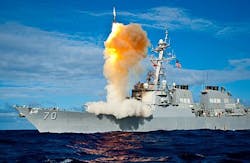Navy taps DRS to build high-power conversion system to satisfy needs of Air and Missile Defense Radar
ARLINGTON, Va., 27 Sept. 2012. U.S. Navy researchers are tapping the DRS Technologies Inc. Power & Control Technologies in Milwaukee to design and demonstrate an advanced shipboard high-power electronics-control system that provides sufficient power for the future Navy Air and Missile Defense Radar (AMDR) for Navy Arleigh Burke-class destroyers.
The Office of Naval Research (ONR) on Monday issued a limited sources justification notice that proposes awarding a $3.7 million 15-month task order to DRS Power & Control for the third phase of the Compact Power Conversion Technologies program, which seeks to satisfy needs of the Navy Electric Ships Office (PMS320) to power the future AMDR.
DRS will build a full-scale advanced shipboard power conversion demonstration system suitable not for a land-based test facility, but also for potential installation aboard Burke-class destroyers.
The company previously built analytical models of the power-conversion system and reduced-scale prototypes. The system is expected to improve today's state-of-the-art shipboard power conversion equipment by two or three times, Navy officials say.
The DRS power conversion system will have three external power interfaces to 450 volts AC, 4,160 volts AC, and 1 kilovolt DC. the power system's normal input power interface will either will be 4,160 or 450 three phase 60 Hz, Navy officials say; the system will be able to receive either input power type.
The 450-volt power interface will meet the guidelines of MIL-STD-1399-300, and the 4,160-volt interface will meet MIL-STD-1399-600. The normal output power external interface will be a 1-kilovolt DC bus.
The Navy is issuing a sole-source contract to DRS to build the power converter because the job is a follow-on to an existing order. Navy officials point out that DRS has in-depth knowledge of the design and necessary manufacturing and testing to build the power system.
Three major U.S. radar houses -- Lockheed Martin Mission Systems & Sensors segment in Syracuse, N.Y.; the Raytheon Co. Integrated Defense Systems segment in Tewksbury, Mass.; and the Northrop Grumman Corp. Electronic Systems segment in Linthicum, Md., are competing to build the AMDR.
For more information on the upcoming DRS contract, contact DRS Power & Control Technologies online at www.drs.com, or the Office of Naval Research at www.onr.navy.mil.
Follow Military & Aerospace Electronics and Avionics Intelligence news updates on Twitter

